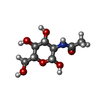+Search query
-Structure paper
| Title | A TMPRSS6-inhibiting mAb improves disease in a β-thalassemia mouse model and reduces iron in healthy humans. |
|---|---|
| Journal, issue, pages | JCI Insight, Vol. 10, Issue 12, Year 2025 |
| Publish date | Jun 23, 2025 |
 Authors Authors | Heinrich E Lob / Nikhil Singh / Kusha Mohammadi / Larisa Ivanova / Beth Crowell / Hyon J Kim / Leah Kravets / Nanditha M Das / Yonaton Ray / Jee Hae Kim / Sylvie Rottey / Emily Labriola-Tompkins / Hazem E Hassan / Lorna Farrelly / Harvey F Chin / Marilena Preda / Leigh Spencer Noakes / Kei Saotome / Matthew Franklin / Marc W Retter / Elif Karayusuf / John J Flanagan / William Olson / Kalyan C Nannuru / Vincent Idone / Michael E Burczynski / Olivier A Harari / Lorah Perlee / Griet Van Lancker / Andrew J Murphy / Aris N Economides / Sarah J Hatsell /   |
| PubMed Abstract | β-Thalassemia is a genetic disorder arising from mutations in the β-globin gene, leading to ineffective erythropoiesis and iron overload. Ineffective erythropoiesis, a hallmark of β-thalassemia, ...β-Thalassemia is a genetic disorder arising from mutations in the β-globin gene, leading to ineffective erythropoiesis and iron overload. Ineffective erythropoiesis, a hallmark of β-thalassemia, is an important driver of iron overload, which contributes to liver fibrosis, diabetes, and cardiac disease. Iron homeostasis is regulated by the hormone hepcidin; BMP6/hemojuvelin-mediated (BMP6/HJV-mediated) signaling induces hepatic hepcidin expression via SMAD1/5, with transmembrane serine protease 6 (TMPRSS6) being a negative regulator of HJV. Individuals with loss-of-function mutations in the TMPRSS6 gene show increased circulating hepcidin and iron-refractory iron-deficiency anemia, suggesting that blocking TMPRSS6 may be a viable strategy to elevate hepcidin levels in β-thalassemia. We generated a human mAb (REGN7999) that inhibits TMPRSS6. In an Hbbth3/+ mouse model of β-thalassemia, REGN7999 treatment led to significant reductions in liver iron, reduced ineffective erythropoiesis, and showed improvements in RBC health, running distance during forced exercise, and bone density. In a phase I, doubleblind, randomized, placebo-controlled study in healthy human volunteers (NCT05481333), REGN7999 increased serum hepcidin and reduced serum iron with an acceptable tolerability profile. Our results suggest that, by both reducing iron and improving RBC function, inhibition of TMPRSS6 by REGN7999 may offer a therapy for iron overload and impaired erythropoiesis in β-thalassemia. |
 External links External links |  JCI Insight / JCI Insight /  PubMed:40548380 / PubMed:40548380 /  PubMed Central PubMed Central |
| Methods | EM (single particle) |
| Resolution | 3.29 Å |
| Structure data | EMDB-49728, PDB-9nrc: |
| Chemicals |  ChemComp-NAG:  ChemComp-CA: |
| Source |
|
 Keywords Keywords | MEMBRANE PROTEIN / Serine protease / Matriptase |
 Movie
Movie Controller
Controller Structure viewers
Structure viewers About Yorodumi Papers
About Yorodumi Papers





 homo sapiens (human)
homo sapiens (human)